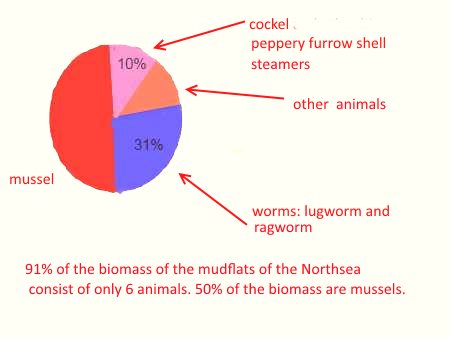cockel
The cockel is an important shore bivalve living in the mudflats of the north sea.
cockel shell
The shell is strong and has a rounded heart-shaped bivalved shell with prominent ribs and concentric ridges. The cockle is buried in the sediment so it can’t be scoured out by waves and currents. The cockle’s large, mobile foot allows it to burrow under the surface, but its short siphons mean it can burrow only deep enough just to cover the shell.
The shell of a cokel on the beach
The biggest enemy of the cockel is the the common whelk. The cockel is found by their smell The whelks drills a holes into to the top of the cockel.
cockel shell
Cockels are filter feeders, drawing water inside through their gills to get both the food and oxygen they need. Cockels need to be submerged for at least three hours per day for feeding and breating. Cockels remove both plankton and fine minute particles of organic debris and help to keep the water clear.
cockel collecting
Cockels are collecting by raking them from the sands at low tide. This is both dangerous and hard work.

Cockle fishing is damaging the mudflats and thus the future food supply for many other animals living in these mudflats. Intertidal mudflats are widespread on the Atlantic coasts of Europe, particularly in the large estuaries feeding into the North Sea and around the North sea islands.
cockel and mudflats
Mudflats are those parts of the Northsea that are covered by the sea at high tide and exposed as the tide goes out. They can be found aroumd the Northsea in sheltered coastal inlets, such as harbours and estuaries and around the islands. Mudflats are created because the water movements slow down and allows fine silts and clays to settle from the water onto the seabed. Mudflats are teeming with life especially with worms and bivalves, but also to shore crabs, shrimps and sea snails and a few seaweeds. The worms, like ragworms and lugworms, and cockles and other bivalves live under the surface of the mudflats, protected from the waves and wading birds. Mudflats are hugely important, as they are the larders of the seashore world, providing food for breeding and wintering waterfowl and wading birds. Cockle fishing is damaging the mudflats and thus the future food supply for many other animals living in these mudflats. Other treats are bait-digging, reclamation, pollution and sea level rise.

The cockel forms about 9% of the weight of all the animals living in the Northsea mudflats.

a tidepool, an illustration of Theo Carreras, 1903. "The world of animal live".
1 strawberry anemone
2 beadlet anemone
3 beadlet anemone
4 cockles
5 common starfish
6 Scallop
7 purple shell
8 periwinkle
9 acorn-barnacles
10 dulse
11 mussel
12 Blackheaded gull